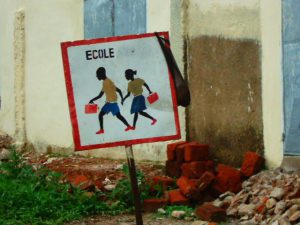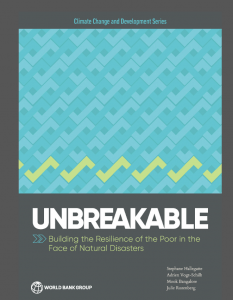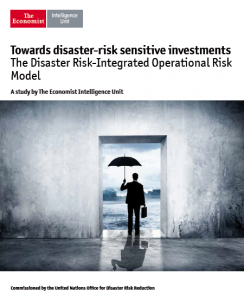 Check out the photo essay developed when working in Guinea, a French-speaking country in Sub-Saharan Africa. Guinea is desperately poor and particularly vulnerable to the impacts of climate change. Sometimes the dirt road at the school crossing is flooded during the rainy season; other times, it is bone dry during the drought periods. Taking these photographs was somewhat risky, as army personnel were ready to arrest anyone with a camera, based on the belief that photographs were likely intended to embarrass the country’s leadership. But a few quick snapshots captured the contrast between the children who were happy to do what few in their region do – go to school – and the extreme poverty in which they live.
Check out the photo essay developed when working in Guinea, a French-speaking country in Sub-Saharan Africa. Guinea is desperately poor and particularly vulnerable to the impacts of climate change. Sometimes the dirt road at the school crossing is flooded during the rainy season; other times, it is bone dry during the drought periods. Taking these photographs was somewhat risky, as army personnel were ready to arrest anyone with a camera, based on the belief that photographs were likely intended to embarrass the country’s leadership. But a few quick snapshots captured the contrast between the children who were happy to do what few in their region do – go to school – and the extreme poverty in which they live.
Unbreakable: Building the Resilience of the Poor in the Face of Natural Disasters
 Because the poor tend to work in sectors that are vulnerable to extreme weather events, live in fragile housing in high-risk areas, and have fewer resources, they are disproportionately affected by natural disasters and often are driven deeper into poverty when disasters occur, according to a recent report from the World Bank and Global Facility for Disaster Reduction and Recovery. The report, Unbreakable: Building the Resilience of the Poor in the Face of Natural Disasters, estimates that natural disasters drive twenty-six million people worldwide into poverty each year, with an average economic loss of $300 billion and a reduction in human well-being of $520 billion. The report argues that to reduce poverty we must reduce disaster risk. Policies that enable resilience and the ability of the poor to recover from unavoidable disasters could reduce losses in human well-being by $100 billion a year. These include revenue diversification programs, including cash transfers from other social programs, to reduce reliance on a single income source; financial inclusion programs designed to help the poor accumulate savings or access credit during post-disaster recovery periods; adaptive social protection programs that provide flexible support to victims of disaster; and disaster risk financing in support of preparedness, recovery, and reconstruction efforts.
Because the poor tend to work in sectors that are vulnerable to extreme weather events, live in fragile housing in high-risk areas, and have fewer resources, they are disproportionately affected by natural disasters and often are driven deeper into poverty when disasters occur, according to a recent report from the World Bank and Global Facility for Disaster Reduction and Recovery. The report, Unbreakable: Building the Resilience of the Poor in the Face of Natural Disasters, estimates that natural disasters drive twenty-six million people worldwide into poverty each year, with an average economic loss of $300 billion and a reduction in human well-being of $520 billion. The report argues that to reduce poverty we must reduce disaster risk. Policies that enable resilience and the ability of the poor to recover from unavoidable disasters could reduce losses in human well-being by $100 billion a year. These include revenue diversification programs, including cash transfers from other social programs, to reduce reliance on a single income source; financial inclusion programs designed to help the poor accumulate savings or access credit during post-disaster recovery periods; adaptive social protection programs that provide flexible support to victims of disaster; and disaster risk financing in support of preparedness, recovery, and reconstruction efforts.
New York Times Reports Business Support of Climate Agreement
The New York Times has reported the statement signed by 365 business leaders and investors urging President-Elect Trump to support the Climate Agreement concluded in Paris last year. Investing in a low-carbon economy is not only good for the environment, it advances American prosperity and job creation. Prisere LLC is among the U.S. businesses that signed the letter, affirming our commitment to reduce our carbon footprint and create jobs in the clean energy economy.
Disaster Risk Analysis from The Economist
 A report released this week, Towards Disaster-Risk Sensitive investments: The Disaster Risk-Integrated Operational Risk Model, presents the results of a pilot study of the Economist Intelligence Unit’s model conducted from January to April this year in twenty disaster-prone locations: Australia, Bangladesh, China, Greece, Haiti, Honduras, India, Italy, Japan, Laos, Madagascar, Niger, Papua New Guinea, Peru, Philippines, Russia, the Republic of Korea, Taiwan, Tajikistan, and the United States. Only Australia, Italy, the Republic of Korea , Taiwan and the USA are judged to have a “mature” approach to economic resilience. (The findings with respect to the U.S. surprised us!) The Economist model, developed with UNISDR’s Risk Knowledge Services division, is built around five pillars: institutional framework; disaster risk-reduction policy, preparedness and response; economic resilience; societal resilience; and resilience of the physical environment. They are measured according to 23 separate indicators, both qualitative and quantitative. It is great reading. Download the report for free at this link.
A report released this week, Towards Disaster-Risk Sensitive investments: The Disaster Risk-Integrated Operational Risk Model, presents the results of a pilot study of the Economist Intelligence Unit’s model conducted from January to April this year in twenty disaster-prone locations: Australia, Bangladesh, China, Greece, Haiti, Honduras, India, Italy, Japan, Laos, Madagascar, Niger, Papua New Guinea, Peru, Philippines, Russia, the Republic of Korea, Taiwan, Tajikistan, and the United States. Only Australia, Italy, the Republic of Korea , Taiwan and the USA are judged to have a “mature” approach to economic resilience. (The findings with respect to the U.S. surprised us!) The Economist model, developed with UNISDR’s Risk Knowledge Services division, is built around five pillars: institutional framework; disaster risk-reduction policy, preparedness and response; economic resilience; societal resilience; and resilience of the physical environment. They are measured according to 23 separate indicators, both qualitative and quantitative. It is great reading. Download the report for free at this link.
Disaster Risk Reduction Course
A Resilient Future: Science and Technology for Disaster Risk Reduction, a course offered by the École Polytechnique Fédérale de Lausanne, is now available online for free or for $50 if you desire a certificate of completion. This course demonstrates how science and technology help to increase disaster risk and increase resilience. Course participants are introduced to existing and emerging technologies suitable for disaster risk reduction while promoting the overall aim of sustainable development. The course focuses on three main natural hazards: floods, landslides and earthquakes. At the conclusion of the course, participants will be able to:
- Explain Disaster Risk Reduction (DRR) related concepts and science and technology for DRR.
- Identify and describe existing and emerging technologies for landslide and flood reduction.
- Explain methodological tools to assess vulnerabilities and risk and strengthen the resilience of communities at risk of landslides, floods and earthquakes.
- Exemplify the role and the challenges of science and technological innovations for disaster risk reduction in an interdisciplinary manner including the importance of social aspects.
- Recognize some of the actors active in DRR and international policy frameworks and technology for DRR.
The instructor, Dr. Silvia Hostettler, is the Deputy Director of the Cooperation & Development Center at the École Polytechnique in Switzerland, where she is responsible for coordinating research activities and for directing the Biennial International Conference of the UNESCO Chair in Technologies for Development. As this course is a great resource for our graduate student interns to help them get started with our projects, we highly recommend it.
